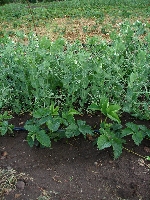Author: Sandra Dane, Pure Horticultural Research Station
At first glance, the term "mixed plantings and sowings" may seem very complicated and unseen in everyday countryside, however, this type of farming has been known since ancient Roman times, when cereals were sown in spaces between rows of olive tree plantations. Here mixed plantings have been known for a long time. One of its most well-known forms is meslin.
In Latvia, this technology is widely used in grain farming, by sowing meslins or cereals with after-sowing of another crop. Mixed planting and sowing are simultaneous cultivation of two or more crops in the same field, which may have similar or significantly different harvesting times. When two or more cultivated plants are grown in spatial proximity, they interact with each other, for example, use companion plants in meslins, plant or sow the second crop, when the first crop has been growing for some time and live mulch, which is sown in space between rows, use as a mulching material and many other options. If the residues of the previous crop are left on the field and not incorporated into the soil, mixed planting and sowing also includes growing cultivated plants within the same vegetation period one after the other. A prime example is living mulch, which is obtained by growing specially selected pre-plants, which are broken with a roller crimper and left on the field, before the next cultivated plant is planted or sown in the created living mulch.
Mixed plantings and sowings, where the correct plant combination and ratio has been chosen, gives a chance to better use solar radiation, water resources and nutrients, as well as better suppress weeds, reduce the spread of harmful insects and can limit the spread of diseases, which in turn, reduces the need to use plant protection products.
A follow-up article will be available in a handbook on climate-friendly agricultural practices.
